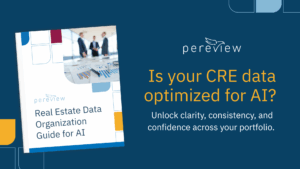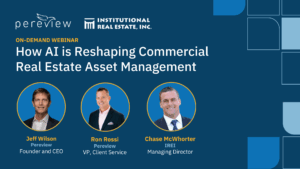Wherever there’s data, there’s going to be dirty data.
“The only time a company could have clean data is on day one,” says Daryl Pitts, Pereview’s senior vice president of sales. “And even on day one, they may have compromised venture capital or start-up data.”
Dirty data can propagate throughout the entire lifecycle of a commercial real estate asset. For example, an underwriter makes a data entry error, which gets passed down to finance when the asset graduates into that stage. No one in finance discovers the error, which is passed down to the portfolio managers, and so forth.
Software exacerbates this issue.
Three-quarters of commercial real estate companies are relying on Excel or another spreadsheet software as their primary asset database.
No offense to Excel, but it’s a terrible database.
“Information stored in spreadsheets is rarely integrated with the rest of the firm,” says Derek Thornhill, vice president of the real estate practice at Saxony Partners. “It ends up siloed in Excel or a deal pipeline system.”
Since dirty data is inevitable, you might wonder if it’s really such a big problem. The truth is that the business costs of dirty data are numerous and serious.
The business costs of dirty data
Risky business
If dirty data is injected into the asset lifecycle, it can increase reputational and operational risk. Reputational risk increases when you report bad data to, say, shareholders, or the government. Operational risk increases as more and more staff are looped into proprietary, siloed processes. If a critical data trove is siloed within the underwriting team and a key member of that team quits, that leads to trouble.
Reporting sucks
Siloed data decreases efficiency, and decreased efficiency within the context of LOTA shows up in the reporting process. Monthly and quarterly reporting with dirty data is painful, requiring lots of staff and countless key stokes.
More assets, more headcount
One of the business costs of dirty data is almost immediate. Firms hire more staff to manage demand created by dirty data and manual reporting. It’s why headcount and assets-under-management tend to increase proportionally. This is inefficient from a personnel standpoint and negatively impacts the firm’s bottom line.
“Investors are demanding quicker turnaround in reporting cycles, both in standard reporting and ad-hoc needs,” Thornhill says. “These reports are often generated in Excel and either posted to a shared drive or an investor portal. More savvy investment firms have automated some of the reporting to the investor, but there is significant legwork behind the scenes to provide this transparency.”
How to avoid the business costs of dirty data
Pereview is the antidote for dirty data.
An all-in-one commercial real estate asset software solution, Pereview is the only Life of the Asset® platform on the market today. It integrates all your data in one place, eliminates siloed systems and processes, allows for push-button reporting, and establishes standard workflows and guidelines for asset and data management.
Let’s chat about how we can ensure that your data is clean, accessible, and secure.



